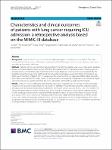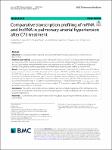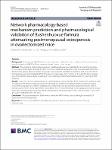Search
Author
- Daqing, Ma (3)
- Anna, Lybeck (2)
- Ashish K., Khanna (2)
- Dan, Bieler (2)
- next >
Subject
- intensive care unit (8)
- acute respiratory dist... (5)
- chronic obstructive pu... (5)
- ICU (5)
- next >
Date issued
Search Results
Lung cancer (LC) is the most common solid tumor type in the intensive care unit (ICU). This study investigated the characteristics of LC patients admitted to the ICU, the major reasons for their admission, short-term mortality, and associated risk factors. |
To investigate mRNA and long non-coding RNA (lncRNA) expression profiles in monocrotaline (MCT)- mice. |
Respiratory infections are the most common reason for admission to paediatric intensive care units (PICU). Most patients with lower respiratory tract infection (LRTI) receive broad-spectrum antimicrobials, despite low rates of bacterial culture confirmation. Here, we evaluated a molecular diagnostic test for LRTI to inform the better use of antimicrobials. |
Postmenopausal osteoporosis (PMOP) is a common bone disorder characterized by low bone mineral density and microstructure deterioration [1]. It is estimated that more than 15% of postmenopausal women over 50 years old are suffering in PMOP worldwide [2]. Most of them have low back pain, hunchback and fragility fractures in different degrees [3]. Although there exist a large amount of anti-osteoporosis drugs such as active vitamin D, estrogen receptor modulators, bisphosphonates and parathyroid hormone [4], various undesirable effects limit their application and efficacy [5]. Natural products and herbs attract increasing attention for their potential anti-osteoporosis effects and relative safety |
Chest radiographs are routinely performed in intensive care unit (ICU) to confirm the correct position of an endotracheal tube (ETT) relative to the carina. However, their interpretation is often challenging and requires substantial time and expertise. The aim of this study was to propose an externally validated deep learning model with uncertainty quantification and image segmentation for the automated assessment of ETT placement on ICU chest radiographs. |
Globally, are skincare practices and skin injuries in extremely preterm infants comparable? This study describes skin injuries, variation in skincare practices and investigates any association between them. |
This open educational resource (OER) was developed to ensure best practice and quality care based on the latest evidence, and to address inconsistencies in how clinical health care skills are taught and practised in the clinical setting. The checklist approach, used in this textbook, aims to provide standardized processes for clinical skills and to help nursing schools and clinical practice partners keep procedural practice current. Each skill/procedure is covered in a chapter that has learning objectives, a brief overview of the relevant theory, checklists of steps for procedures with the rationale behind each step of the process, and a summary of key takeaways. Key terms are set in bold throughout the book and laid out again in a Glossary in the appendix. All 88 checklists are als... |
This is a joint project between the McMaster Education Research, Innovation, and Theory (MERIT) unit, McMaster Faculty of Health Sciences Program for Faculty Development, and the McMaster Masters in Health Sciences Education program. This e-book has been published via McMaster University, Faculty of Health Sciences, Office of Continuing Professional Development. The Health Professions Education Research Primer is available under the Creative Commons Attribution-NonCommercial-ShareAlike 4.0 International License (CC BY-NC-SA 4.0). This project is made possible with funding by the Government of Ontario and through eCampusOntario’s support of the Virtual Learning Strategy. To learn more about the Virtual Learning Strategy visit: https://vls.ecampusontario.ca. |
Physical activity and exercise are integral parts of Indigenous identity, woven into cultural tradition throughout history. This resource aims to tell the story of physical activity, exercise, and health in Indigenous communities.
Divided into four main sections, learners will begin their journey by uncovering some of the history of physical activity in Indigenous health. The learner will then explore and appreciate physical activity and health in Indigenous communities at the present time. Finally, learners will be guided towards moving forward in physical activity and health together.
This resource may be used as a stand-alone online learning experience and/or for an academic course. Features include: wholistic learning objectives, informational text, suggested readings and ... |
The purpose of this textbook is to help learners develop best practices in vital sign measurement. Using a multi-media approach, it will provide opportunities to read about, observe, practice, and test vital sign measurement. |










